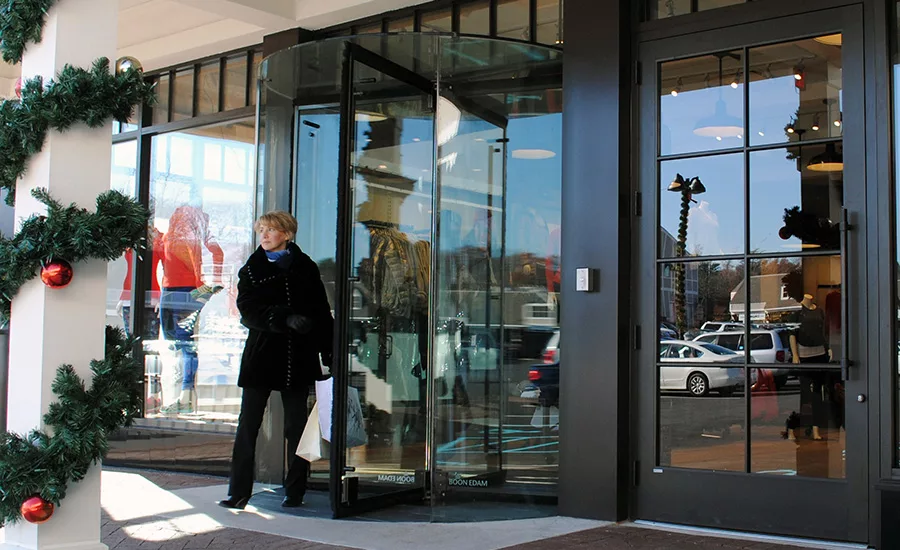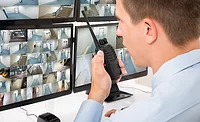3 Ways Entrances Can Make Money for Your Enterprise

We’ve all used different types of entrances as we move about in the world: swing doors, sliding doors, revolving doors, gates and turnstiles. Aside from providing access into buildings, how many people consider that certain types of entrances can reduce costs and sometimes create opportunities to make money?
Replacing Security Personnel
When it comes to commercial office buildings and government buildings, it’s important to have a physical security plan, and to determine the policies for mitigating unauthorized entry into secure areas. If there are significant assets and people to protect, your policies will likely include the use of access control and video surveillance systems, as well as manned security. If you are using these elements and currently have swinging doors or sliding doors, or even waist-high turnstiles or optical turnstiles, then unauthorized entry (tailgating) is a risk. Therefore, manned security must be ever-present and attentive to prevent tailgating.
There are two other classes of security entrances that further reduce the risk of tailgating. They operate to make tailgating extremely difficult or impossible and, importantly, do not require constant security staff to monitor the entrance or be “just around the corner on standby.” These two entrances are security revolving doors and security mantrap portals. Such entrances can be used for employee-only access to buildings, or to protect access to sensitive areas within buildings. Reduction or redeployment of security personnel saves serious money that can be used to fund other security needs. Redeployed security personnel can also be used for more productive security functions than watching an entrance. Both of these outcomes create measurable return on investment.
Reducing Needed Staff and Creating Energy Savings
Universities around the world are seeing significant payback by using turnstiles to deter unauthorized entry and control traffic into libraries, residence halls and recreational facilities. Although turnstiles do not prevent tailgating if someone is determined to get in, they are used to support staff, often students, who are compensated to monitor such entrances. If large numbers of students converge during a short time span, then staff can easily be overwhelmed and infiltrators could get lucky. However, the barriers force students and guests to wait their turn, sign in, etc. All of this is possible now by using fewer staff than without the turnstiles. So, again, there is the benefit of reallocation or reduction in paid staff positions and a more secure environment as a result.
Any type of building can “make money” by deploying revolving doors vs. swinging or sliding doors. When sliding or swinging doors open, they create a hole in the side of a building. If the building experiences a high amount of traffic – such as hospitals, hotels, urban office buildings, retail, restaurants or even busy convenience stores – then the amount of lost conditioned air becomes staggering, and the HVAC system must make up the difference. Imagine a retail store invests in marketing and sales promotions resulting in tons of business, but then gets “punished” for their success with much higher energy bills. MIT did a study in 2006 of a single building on their campus, and they calculated that revolving doors allow roughly eight-times less air infiltration than swinging doors. The study proposed that if people used both of the building’s revolving doors 100 percent of the time, MIT would save almost 15 tons of CO2, which is enough to heat five homes for one year. If all commercial buildings switched to revolving doors, and people were encouraged to use them, the total energy savings would be enough to eliminate a very large amount of power-producing capacity.
Maximizing Useable Space Creates Revenue
When it comes to retail and restaurants, revolving doors make money in other ways. The most obvious benefit easily felt is the reduction of drafts and wind blowing into the interior. For spaces used to entertain guests, a thoughtful redesign of the existing floorplan will use every square-foot of floor space to create revenue. Ever been seated in a restaurant near the front door and felt the cold wind blowing in? More than likely you asked to be reseated. Or, have you left a cold, drafty hotel lobby to dine or drink elsewhere? This lost revenue can be recaptured. Revolving doors provide a level of comfort that keeps guests inside the establishment by allowing use of nearly every possible square foot, for longer periods of time. Bonefish Grill redesigned their floorplan so that with a revolving door, guests can flow right into a lively bar and start spending money immediately, instead of waiting with nothing to eat or drink until a dinner table opens up.
From a retail perspective, no wind and no drafts mean promotional items, signage and new inventory can be moved closer to the entrances than before, maximizing expensive floor space to create more revenue opportunities. In fact, some large automatic revolving doors have display cases built into their large door wings that can be filled with the hottest toys or fashion items to grab customer attention the minute they enter the store and encourage them to buy.
Building Entrances – Who Knew?
Everyday run-of-the-mill entrances, right? We rarely give them a second thought. Yet, as we’ve discussed here, the right entrance, along with re-designed floor plans and moving the “action” closer to the entrance, can result in substantial costs savings and multiple opportunities to finds ways for businesses to make more money. Who knew something as common as the building entrance could affect the bottom line in such positive ways and provide measurable ROI?
Looking for a reprint of this article?
From high-res PDFs to custom plaques, order your copy today!








